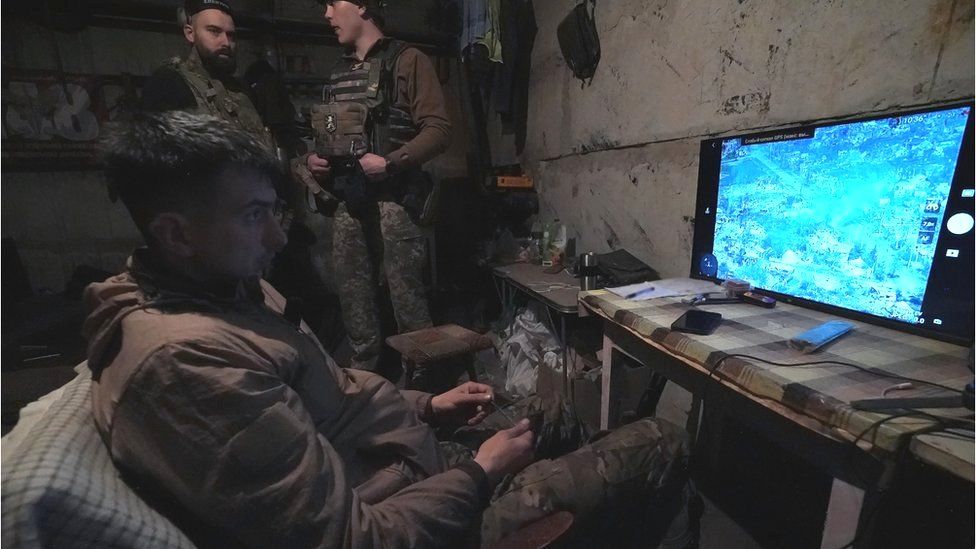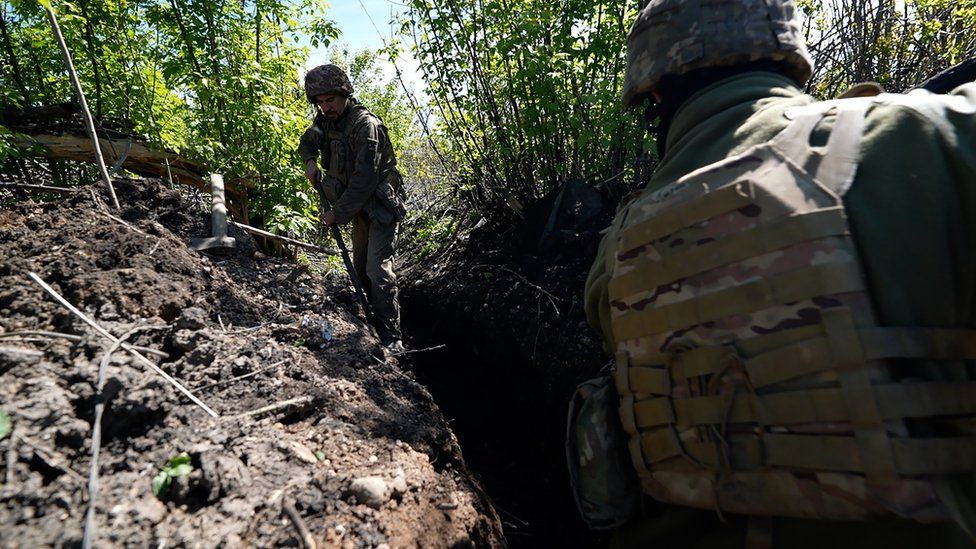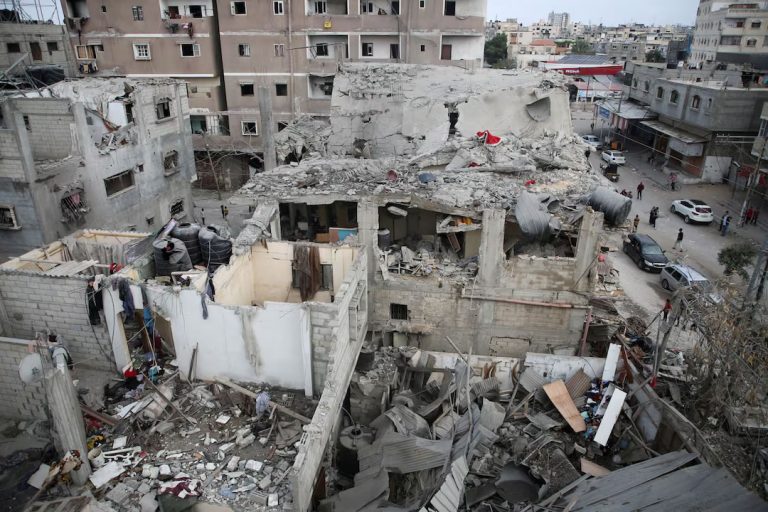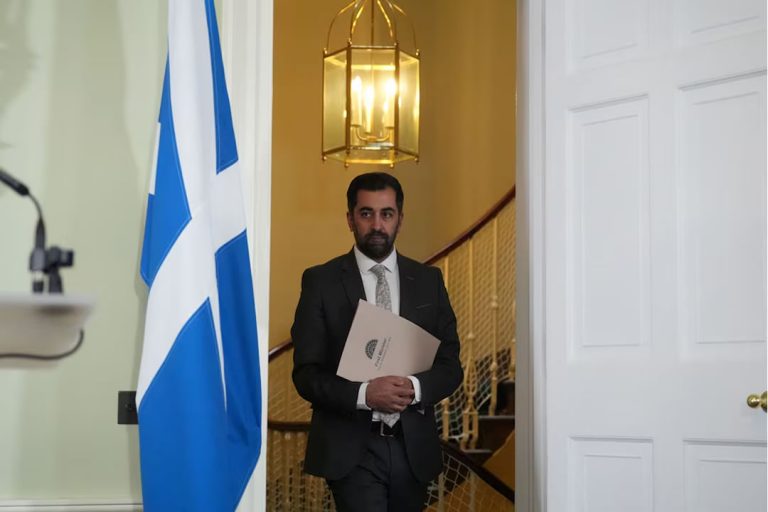
In a bunker just outside the city limits of Bakhmut, Ukraine’s 77th Brigade direct artillery fire to support their infantry – their last line of defence on the western edge of the city.
Ukraine is still clinging to the last few streets here.
But the live video feed the artillery gunners watch intently, from a drone flying above the city, suggests that even if Russia can finally wrestle control, it would be little more than a pyrrhic victory.
The prize is now a crumpled, skeletal city – with hardly a building left unscathed, and with its entire population vanished.
The battle for the eastern Ukrainian city of Bakhmut has been the longest and bloodiest of this war so far. Western officials estimate between 20,000 and 30,000 Russian troops have been killed or wounded here, while Ukraine’s military has also paid a heavy price – and it still isn’t over.
The plumes of smoke still hang heavy over the besieged city, accompanied by the relentless rumble of artillery fire.
Russia has been trying to capture Bakhmut for months, and it’s been a testament – so far – to Ukraine’s determination not to give ground. But it’s also a reminder that its coming counteroffensive could prove far more challenging.

Back in the bunker, Ukraine’s 77th Brigade orders another artillery strike on a house. Seconds later a plume of smoke rises from the rubble. Two men emerge from the smoke, stumbling down a street. One appears to be injured.
I ask if they’re Wagner soldiers – the Russian paramilitary force which has been leading the assault. “Yes,” replies Myroslav, one of the Ukrainian troops staring at the screen.
“They are fighting quite well, but they don’t really care about their people,” he says.
He adds that they don’t seem to have much artillery support and they just advance in the hope that they’ll be “luckier than the last time”. His comrade, Mykola, interjects: “They just walk towards us, they must be on drugs.”
Looking at this shell of a city it’s hard to understand why either side has sacrificed so many lives for it.
Mykola admits that the defence has also been costly for Ukraine. He says many soldiers have given their lives, and it’s hard to fight in the densely packed streets. He says they’ve been replaced by troops with less experience, but adds: “They will become the same warriors as those who fought before them.”
To the south of the city, Ukraine’s 28th Brigade has been helping prevent Bakhmut from being encircled.
The Wagner forces they once faced have already been replaced by paratroopers of Russia’s VDV, or airborne forces. But they’re still locked in daily skirmishes.
During a lull in the fighting, Yevhen, a 29-year-old soldier, takes us on a tour of their defensive position in a small wood.
The arrival of spring has provided them with some leaves for cover, but many of the trees have been stripped by the constant shelling.

As we run from a trench, across exposed ground pock-marked by shell holes, the Russians open fire with their mortars. “That was pretty damn close,” says Yevhen in perfect English as we reach some cover.
As we move to another position he says: “Now we’re going to fire back.”
Minutes later his men follow up with a volley of small arms fire and rocket-propelled grenades (RPGs). There are no casualties this time. But hours after we leave one of their soldiers is seriously injured.
President Volodymyr Zelensky has called Bakhmut “a fortress” of Ukrainian morale. Yevhen displays that determination not to give up. “The whole point of Bakhmut is to keep the enemy there,” he says.
If Ukraine gave up Bakhmut, he says, they’d only lose more lives later. “We could retreat to save a few lives, but we would then have to counter-attack and we’d lose even more”.
Ukraine’s hope is that the fight over Bakhmut has blunted Russia’s ability to conduct its own offensive operations, and exhausted its army and supplies.
But Russia has also been preparing to stymie Ukraine’s upcoming offensive.
Recent satellite images of the occupied south show it has built hundreds of miles of deep trench lines and dragon’s teeth tank traps to slow down any attempted advance. More difficult to punch through than the razor wire and mines we saw in front of these Ukrainian positions.
Southern Ukraine is where many expect the focus of the Ukrainian offensive to be. Russia has already ordered a partial evacuation near the nuclear power plant at Zaporizhzhia.
Ukraine, too, has been rationing artillery rounds in preparation for an attack that will be spearheaded by newly trained brigades of troops and some of the 1,300 armoured vehicles and 230 tanks supplied by the West. Though we have also witnessed convoys of Western military equipment heading East.
Meanwhile, Ukraine’s Defence Minister Oleksii Reznikov has tried to dampen down expectations – warning against “overestimating” the outcome.
I ask Yevhen if he feels that pressure too. He says he knows it won’t be easy, but adds: “We’ve already changed the whole world’s opinion of the Ukrainian army and we still have lots of surprises.”
But this time it may prove harder to conceal the element of surprise.
















+ There are no comments
Add yours